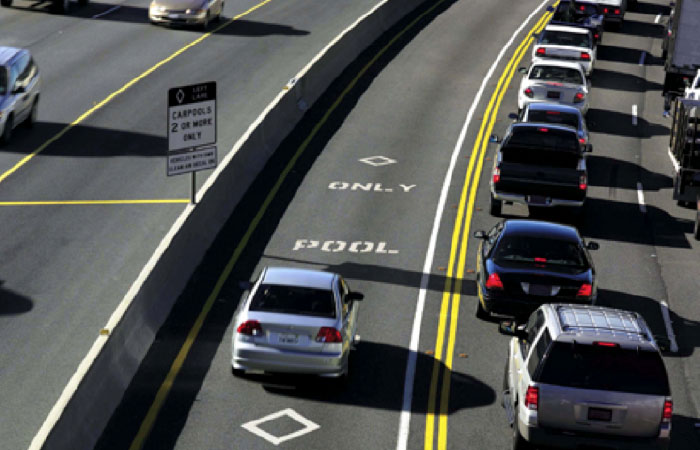Carpool lanes are an essential part of the Bay Area’s transportation infrastructure, designed to encourage carpooling, reduce traffic congestion, and improve air quality. As the population continues to grow in cities like San Francisco, Oakland, and San Jose, the question of whether carpool lanes should be enforced 24/7 has become a topic of debate.
In this comprehensive guide, our experienced personal injury attorneys at GJEL Accident Attorneys discuss the pros and cons of 24/7 carpool lane enforcement and its potential impact on drivers in Northern California.
Bay Area traffic is worse than ever. Whereas traffic jams were once restricted to typical rush hour (7-9 AM, 4-6 PM), congestion now extends earlier and later past the peak periods. For some corridors, such as the Eastshore, Nimitz, and Bayshore Freeways as well as most toll plazas, weekends are often just as bad as weekdays. Moreover, few alternatives exist to driving outside of rush hour: BART, Caltrain, and other transit services are often too infrequent to offer a dependable alternative.
Given this worsening gridlock, carpooling would seem like a great solution to help reduce the number of cars on the road. In Southern California, for example, carpool lanes are active 24/7 to incentivize carpooling during all times of the day.
However, the Bay Area’s carpool lanes are only active part-time during traditional commute hours (Monday-Friday 6-10 AM and 3-7 PM), meaning that a vehicle with five occupants is subject to the same delays as a single-occupancy vehicle.
The differences in Caltrans’ approach to carpool lanes in Northern and Southern California is a product of what has traditionally been a difference in traffic patterns between the regions: Northern California has typically experienced traffic congestion mostly during commute hours, while Southern California has typically experienced all-day congestion:
“The operational practices vary differently between Northern California versus Southern California because of traffic volumes and commuter patterns in the two regions. Northern California highways usually experience two weekday congestion periods during peak morning and afternoon commute hours, followed by a long period of non-congestion. Full-time operation would leave the HOV lane relatively unoccupied during off-peak hours and would not constitute an efficient use of the roadway. Southern California normally experiences very long hours of congestion, typically between six to eleven hours per day, with short off-peak traffic hours. Part-time operation under these conditions is generally considered infeasible.”
– Source: AB 210 Assembly Floor Analysis
Current Carpool Lane Regulations
Currently, carpool lanes in the Bay Area are enforced during specific hours, typically during morning and evening rush hours. During these times, vehicles with the required number of occupants are allowed to use carpool lanes, while others may face fines or penalties for violations. Outside of these designated hours, carpool lanes are open to all drivers.
Benefits of 24/7 Carpool Lane Enforcement
There are several potential benefits to enforcing carpool lanes 24/7:
- Reduced Traffic Congestion: Continuous enforcement of carpool lanes could further encourage carpooling, helping to reduce the number of single-occupancy vehicles on the road and alleviate traffic congestion.
- Improved Air Quality: With fewer vehicles on the road, air quality could improve due to reduced emissions.
- Consistent Rules: 24/7 enforcement would eliminate confusion among drivers regarding when carpool lane restrictions apply, creating a more predictable and consistent driving environment.
Drawbacks of 24/7 Carpool Lane Enforcement
However, there are also potential drawbacks to enforcing carpool lanes around the clock:
- Increased Enforcement Costs: Continuous enforcement would require additional resources, such as increased law enforcement presence, which may strain already limited budgets.
- Potential Increase in Traffic Violations: 24/7 enforcement may lead to more carpool lane violations, as drivers may be tempted to use these lanes when they are less congested during non-peak hours.
- Reduced Lane Availability: Enforcing carpool lanes 24/7 would reduce the number of available lanes for all drivers, potentially exacerbating traffic congestion during non-peak hours.
Legal Consequences of Carpool Lane Violations
Violating carpool lane regulations can result in hefty fines and potential points on your driving record. Our experienced personal injury attorneys at GJEL Accident Attorneys are well-versed in traffic laws and can help you navigate the legal complexities of carpool lane violations in Northern California.


